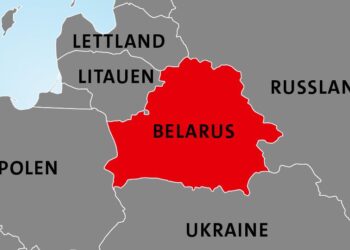Poland has officially closed its border with Belarus, effectively severing a critical rail connection between China and Europe. This move disrupts a key segment of the New Silk Road trade route, which has facilitated the overland transit of goods across the Eurasian continent. The closure marks a significant escalation in regional tensions and poses fresh challenges for supply chains that rely on this corridor. This article examines the implications of Poland’s decision for international trade, geopolitics, and the future of Sino-European rail links.
Poland Shuts Border with Belarus Disrupting Key China-Europe Rail Corridor
Poland’s recent decision to close its border with Belarus has caused significant disruption to a critical rail corridor connecting China and Europe. This route, vital for the smooth transit of goods under the Belt and Road Initiative, has faced immediate suspension, impacting supply chains and increasing transit times. Polish authorities cited security concerns and political tensions as the primary reasons for the move, which has left logistics companies scrambling to identify alternative pathways.
Key ramifications of the border closure include:
- Delays in cargo delivery affecting industries reliant on just-in-time supply.
- Rerouting of trains through longer and less efficient routes, driving up costs.
- Heightened geopolitical strains between the EU, Belarus, and indirectly China.
| Impact Area | Estimated Effect |
|---|---|
| Transit Time | +30% increase |
| Logistics Costs | +20% rise |
| Rail Freight Volume | -40% drop |
Impact on European Supply Chains and Trade Flows Amid Rail Link Closure
The sudden closure of the Poland-Belarus border has sent ripples across European supply chains, abruptly halting one of the continent’s key rail corridors connecting China to Europe. This disruption has forced freight operators and manufacturers to scramble for alternative routes, leading to increased transit times and heightened logistical costs. With the rail link responsible for transporting a significant portion of electronics, automotive parts, and consumer goods, companies reliant on just-in-time delivery have faced mounting pressures to secure inventory ahead of potential further interruptions. The blockage has also intensified competition for sea and air freight capacity, driving prices upward and straining trade flow efficiency.
Key consequences of this rail link closure include:
- Delays exceeding 7-10 days on rerouted Asian-European shipments
- Surge in rail freight rates up to 20% in neighboring transit countries
- Temporary suspension of several scheduled block trains servicing Central and Western Europe
The situation has sparked industry-wide debates on the resilience of Europe’s supply networks and the urgent need to diversify logistical pathways. Stakeholders are fast-tracking initiatives to enhance southern corridor capacity, including ports and rail infrastructure, to alleviate future disruptions stemming from geopolitical tensions or border closures.
| Impact Area | Effect | Estimate |
|---|---|---|
| Transit Time | Increase | +7 to 10 days |
| Freight Costs | Spike | +15% to 20% |
| Rail Volume | Decrease | -30% |
| Alternative Routes | Expansion Needed | Immediate |
Strategies for Businesses to Mitigate Risks from Eastern Transit Route Disruptions
In light of the abrupt closure of Poland’s border with Belarus, businesses heavily reliant on the Eastern transit route must urgently diversify their logistics strategies. One practical approach involves shifting to alternative corridors such as the Southern Corridor through the Balkans or strengthening maritime routes via the Baltic Sea. These alternatives, while possibly longer in transit time, offer critical resilience against single-point failures in the supply chain.
Additionally, companies are advised to implement multi-modal transport solutions that combine rail, road, and sea freight. This hybrid strategy not only mitigates the risk of prolonged disruptions but also enhances flexibility in customs and regulatory compliance.
- Establish multiple supplier bases across diverse geographical locations to avoid over-dependence on the Eastern route.
- Invest in real-time logistics tracking to swiftly react to border closures or delays.
- Build strategic stock reserves at key distribution hubs to cushion short-term supply shocks.
| Risk Factor | Mitigation Strategy |
|---|---|
| Border Closures | Diversify routes; multimodal solutions |
| Customs Delays | Pre-clearance programs; advanced documentation |
| Supply Shortages | Strategic inventory buffers; alternative suppliers |
The recent closure of Poland’s border with Belarus poses significant challenges to businesses relying on the Eastern transit route. To navigate these disruptions, companies should consider the following key strategies:
Alternative Corridors and Routes
- Southern Corridor through the Balkans: Utilize this overland passage as an alternative to the Eastern route.
- Maritime Routes via the Baltic Sea: Strengthen sea freight options to maintain supply flows, despite potentially longer transit times.
Multi-Modal Transport Solutions
- Combine rail, road, and sea freight to increase flexibility and reduce dependency on a single transport mode. This helps navigate regulatory and customs challenges more effectively.
Risk Mitigation Tactics
- Supplier Diversification: Establish multiple supplier bases in various regions to diminish reliance on any single transit corridor.
- Real-Time Logistics Tracking: Invest in tracking technologies to monitor shipments and respond quickly to closures or delays.
- Strategic Stock Reserves: Maintain inventory buffers at key distribution hubs to protect against short-term supply shortages.
Summary of Risks and Mitigation Measures
| Risk Factor | Mitigation Strategy |
|——————-|———————————————————|
| Border Closures | Diversify routes; adopt multimodal transport solutions |
| Customs Delays | Implement pre-clearance programs; use advanced documentation |
| Supply Shortages | Build strategic inventory buffers; secure alternative suppliers |
By proactively adopting these strategies, companies can enhance supply chain resilience and reduce vulnerability to sudden geopolitical disruptions affecting Eastern transit routes.
Wrapping Up
The closure of Poland’s border with Belarus marks a significant disruption in the China-Europe rail corridor, underscoring the ongoing geopolitical tensions impacting global trade routes. As Warsaw enforces the shutdown amid escalating political disputes, freight operators and businesses reliant on this critical link are now compelled to seek alternative pathways, potentially increasing transit times and costs. The full ramifications of this development remain to be seen, but it is clear that the intersection of security concerns and international commerce continues to reshape the landscape of Eurasian connectivity.
















